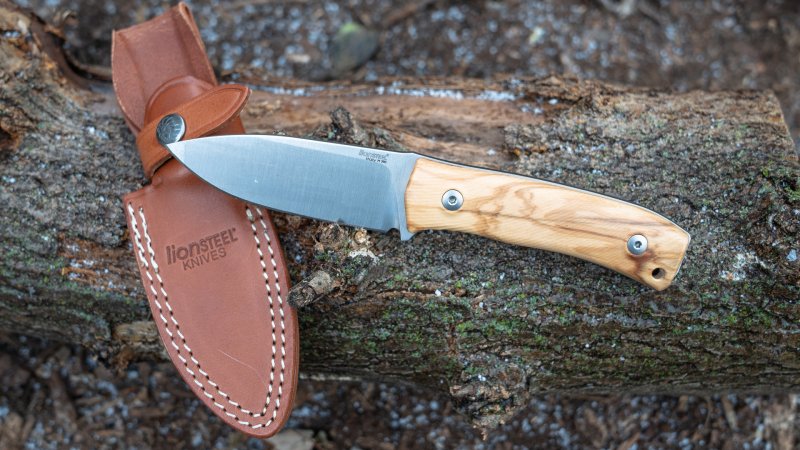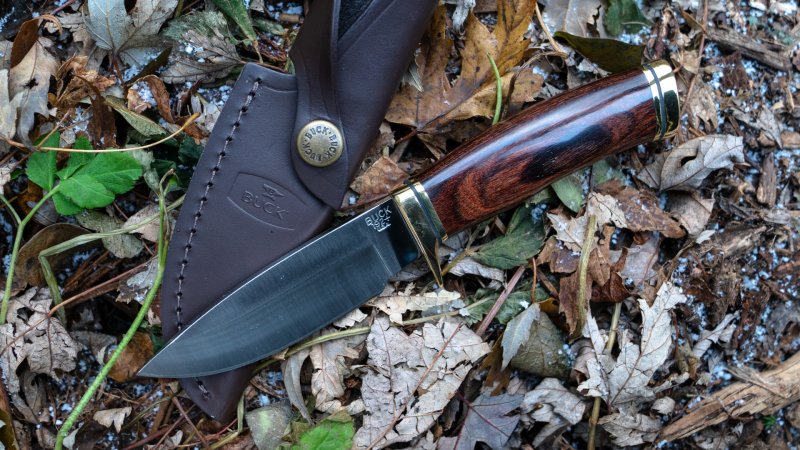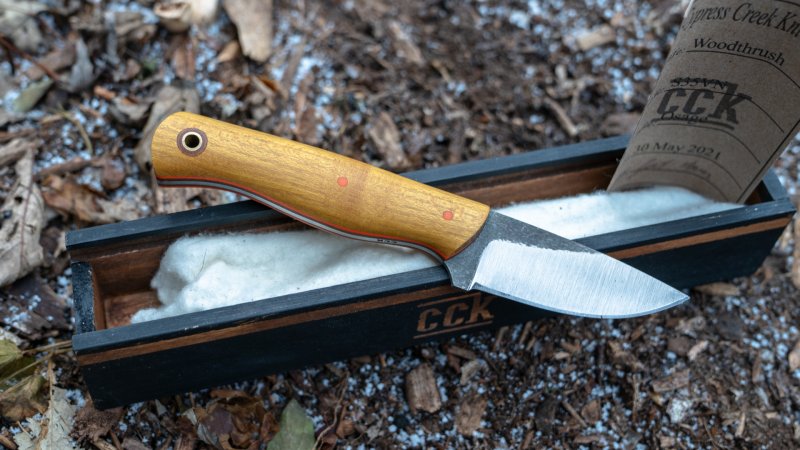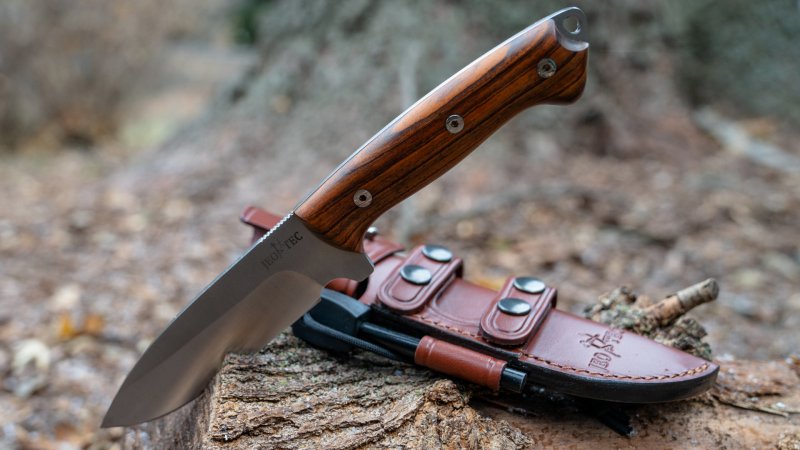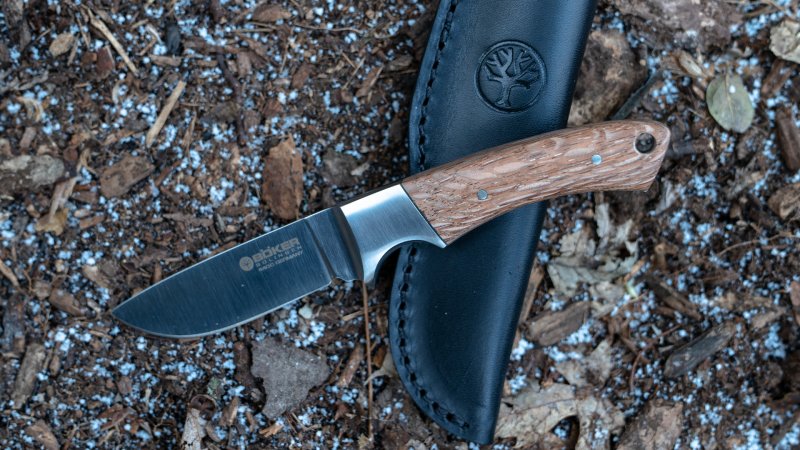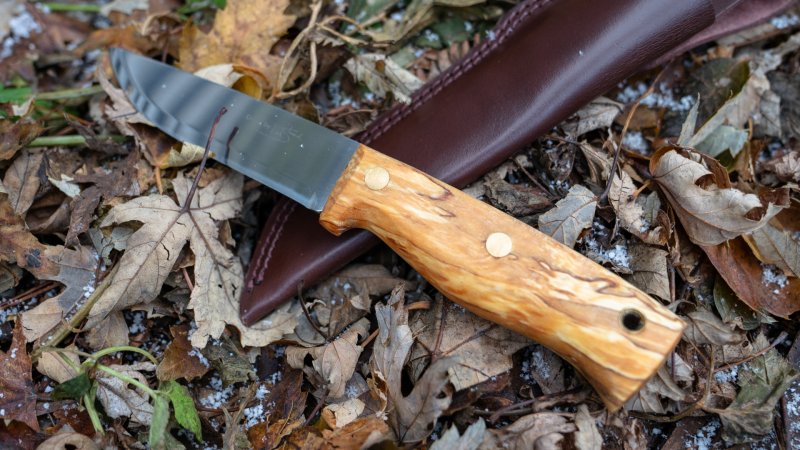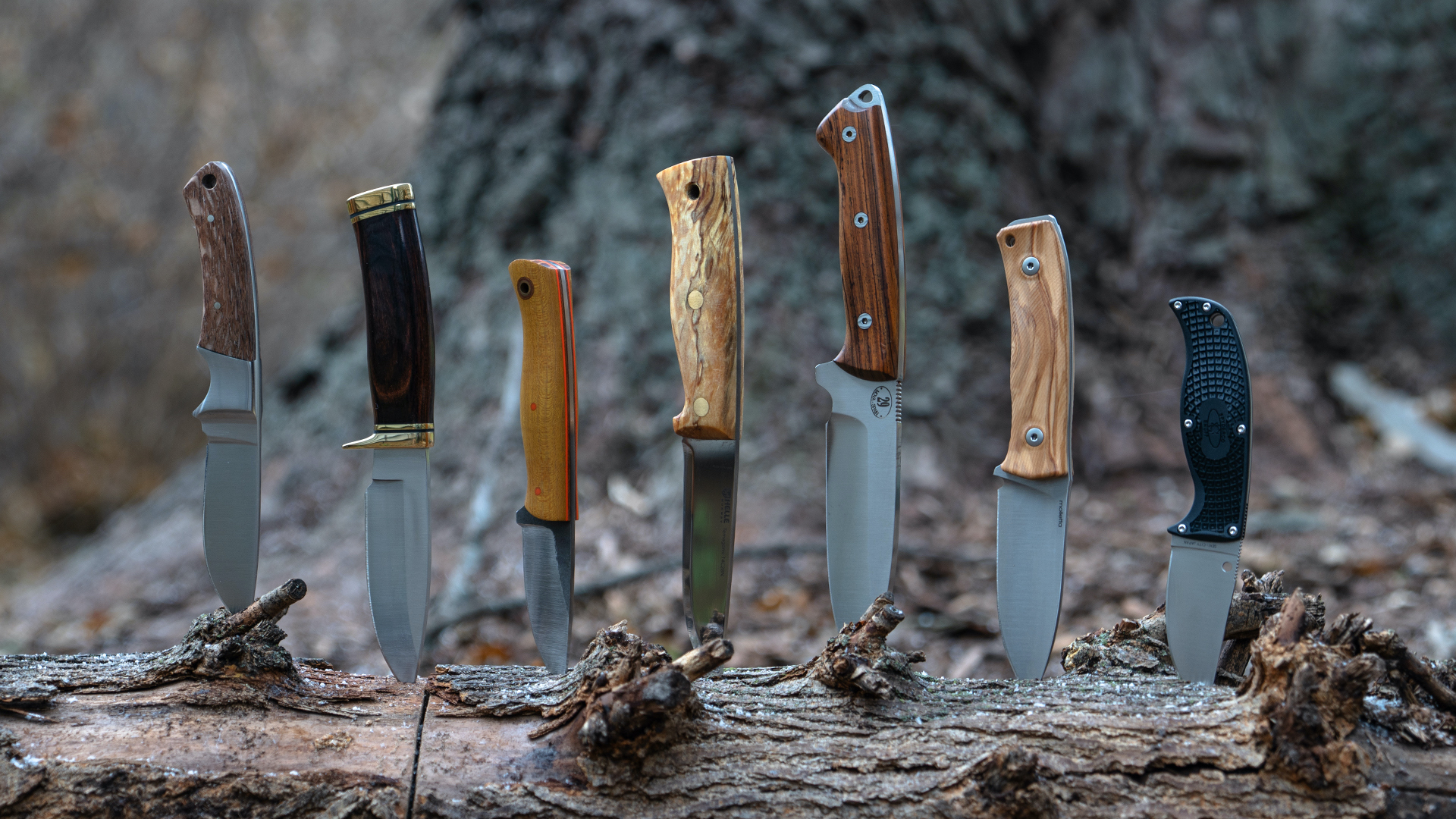

We may earn revenue from the products available on this page and participate in affiliate programs.
When we sat down to start planning our survey of the best hunting knives, it felt like a time to swing big. It seemed like the perfect opportunity to look beyond the usual suspects, dig a little deeper, and find the very best — and most interesting — hunting knives from around the world. We didn’t just want knives that work; we wanted knives that you’ll be excited to see every time you pull one out of the sheath.
To that end, we tracked down knives from six countries on three continents, from bushcraft blades to precision instruments. We spent hours comparing and contrasting various steel alloys, handle materials, blade shapes, and edge grinds. Then, to be absolutely sure that each of these knives was up to the task of serving as your go-to hunting blade, we handed them all over to the pros at Outdoor Addiction Meat Processing in beautiful Blue Mounds, Wisconsin, to see how they stacked up in the eyes of people who turn animals into delicious meat for a living.
The result is one of the most thorough gear roundups we’ve ever done, and it’s one hell of a resource in the search for your new favorite knife out of the best hunting knives out there. Let’s cut to the chase, shall we?
- Best Overall: LionSteel M4
- Best Value: Buck Vanguard 192
- Editor’s Choice: Cypress Creek Knives Woodthrush
- Most Durable: Spyderco Enuff
- Best Heavy-Duty: Jeo-Tec No. 29
- Best for Skinning: Boker Integral Hunter
- Best Heirloom: Helle Temagami LTD
Best Overall
LionSteel M4
Pros
- Bushcraft knife disguised as a hunting knife
- M390 steel is extremely desirable
- Long, flat grind is great for slicing meat
- Fits the hand like a glove
Cons
- Handle gets slippery when wet
- We’d like a more pronounced finger guard
- Is LionSteel a cool or dorky name?
Product Specs
- Country of origin: Italy
- Blade length: 3.75
- Blade profile: Drop point
- Blade grind: Flat
- Steel: M390
- Handle: Olive
- Sheath: Leather
Best Value
Buck Vanguard 192
Pros
- All the features of a good hunting knife
- Looks like a quintessential American hunting knife
- Priced way below what the level of craftsmanship would suggest
- Hollow grind is great for slicing raw meat
Cons
- We’d like the edge to reach the handguard
- Too shiny for some hunters
- Imported sheath doesn’t match the knife’s build quality
Product Specs
- Country of origin: USA
- Blade length: 4.125 inches
- Blade profile: Drop point
- Blade grind: Hollow
- Steel: 420HC
- Handle: Walnut
- Sheath: Leather
Editor’s Choice
Cypress Creek Knives Woodthrush
Pros
- Where else will someone literally sign off on a knife?
- Short blade is precise and user-friendly
- Osage orange is durable and full of history
- Presentation is excellent and creates a sense of occasion
Cons
- Small blade can be limiting
- Doesn’t come with a sheath
- Some yellow pigment rubbed off in the first washing
Product Specs
- Country of origin: USA
- Blade length: 2.875 inches
- Blade profile: Straight
- Blade grind: Flat
- Steel: CPM-S35VN
- Handle: Osage orange
- Sheath: None
Most Durable
Spyderco Enuff
Pros
- Nothing is indestructible, but this is close
- Best grip of any handle here
- Damn-near impervious to rust and corrosion
- Sheath is legitimately tactical
Cons
- Blade length isn’t necessarily always enough
- Lacks the old-world appeal of some other knives
- May result in a Spyderco addiction
Product Specs
- Country of origin: Japan
- Blade length: 2.75 inches
- Blade profile: Straight
- Blade grind: Flat Steel:
- VG-10 Handle: Fiberglass-reinforced nylon
- Sheath: Injection-molded polymer
Best Heavy-Duty
Jeo-Tec No. 29
Pros
- Legitimate bushcraft knife for wilderness survival
- Includes a ferro rod for lighting fires
- Overbuilt sheath can be mounted vertically or horizontally
- Flat grind creates an excellent cutting edge
Cons
- Size and weight may be an issue
- Length isn’t ideal for certain hunting tasks
- Overkill for most situations
Product Specs
- Country of origin: Spain
- Blade length: 4.92 inches
- Blade profile: Drop point
- Blade grind: Flat
- Steel: MOVA-58
- Handle: Cocobolo
- Sheath: Leather
Best for Skinning
Boker Integral Hunter
Pros
- Surgical sharpness out of the box
- Oversized bolster improves grip and overall strength
- Perfect for skinning and making precise cuts
- Fit and finish are superb
Cons
- Small handle is limiting
- Sheath isn’t exactly heavy-duty
- Not as versatile as our other picks
Product Specs
- Country of origin: Germany
- Blade length: 3.5 inches
- Blade profile: Drop point
- Blade grind: Flat
- Steel: 440C
- Handle: Lacewood
- Sheath: Leather
Best Heirloom
Helle Temagami LTD
Pros
- Craftsmanship is a real thing of beauty
- Blade is incredibly strong and durable
- Legitimate bushcraft tool for longer hunts
- Provides plenty to talk about around the campfire
Cons
- Scandi grind isn’t for everyone
- Shiny blade reflects light like a signal mirror
- Act fast to land one of the limited-edition knives
Product Specs
- Country of origin: Norway
- Blade length: 4.33 inches
- Blade profile: Straight
- Blade grind: Scandi
- Steel: 14C28N
- Handle: Curly birch
- Sheath: Leather
Why you should trust us
Here at Task & Purpose, people either show up as a knife nut on their first day or quickly become one. We’ve written reviews on knives for survival, everyday carry, and bushcraft. Hell, we can even help you pick a knife to bust out of a car crash or chuck at a target. If a manufacturer makes a particularly bold claim about their product, you can bet we’ll push it to the limit with something like our signature road-salt immersion test. There’s a lot of ground to cover and we take pride in doing it well. Sometimes that means enlisting the help of people who cut for a living. We’ve reached out to butchers and meat processors more than once to make sure our knives get a thorough shake-down.
Types of hunting knives
Hunting knives encompass a lot of different things, and we spread the love to represent a lot of different styles and tastes on this list. In each case, there’s a reason why we chose what we did. Here’s a breakdown of which factors you need to consider and some of the information we used to get in the right headspace for this guide.
Fixed blade
Hunting knives have typically used a fixed blade, and that’s still true in most cases. Many of the tasks hunting knives are expected to do require a fair amount of force, so being rigid allows them to hold up to the abuse. The lack of any moving parts makes them much stronger than folders.
In terms of size, fixed-blade knives are generally larger than folding knives. That’s fine in this case because hunters don’t need to restrict themselves to knives that fit in a pocket. Large blades are useful when setting up a blind, breaking down big game, and doing chores around the campsite.
We also can’t overlook the maintenance our gear requires. Keeping a fixed-blade knife in peak shape is as simple as sharpening, oiling the steel, and maybe rubbing some wax into the handle.
Folding
The biggest advantage folding knives possess is their compact size. One of our favorites is the Benchmade North Fork, which folds down to a closed length of 3.9 inches. With its slim handle and movable pocket clip, it’s a wonderful, high-end EDC or backup to your primary hunting knife.
No matter what kind of mechanism a folding knife uses, it’s never as strong as a solid piece of metal. Folders aren’t well-suited to more rigorous tasks like breaking down large game animals.
All the small moving parts that allow a folding knife to open and close get filled with gunk, too. Using one as a hunting knife will result in sticky blood and all kinds of other nastiness gumming up the works. That requires stripping the knife down to individual components, cleaning each one, and (worst of all) putting it all back together.
Key features of hunting knives
Type of steel
A knife’s worth arguably begins and ends with the steel used to make the blade. Garbage in equals garbage out, as they say. Blade HQ has an informative resource for navigating the best blade steels, but there are a few basics you should understand whether or not you venture down the rabbit hole.
Every steel used in knife-making is judged by four metrics: edge retention, toughness, corrosion resistance, and ease of sharpening. Improving one often leads to sacrificing another. Improving everywhere involves a lot of costs that are passed on to the consumer.
None of the four metrics is inherently more important than another, so you’ll have to decide for yourself which takes priority in your buying decision. The knives on this list perform respectably in all areas but have very different characteristics to consider if you want to get into the weeds.
Profile
A knife’s profile is the shape of the blade when viewed from the side. Different profiles are used to perform different tasks. Most hunting knives use a drop point because of the profile’s strength and ability to perform most tasks well. It’s great for both slicing and puncturing and can be used to make very precise cuts.
Two of our picks use a straight profile. This old-school shape is simple (read: less expensive) to manufacture and has been used for thousands of years with great success. If it ain’t broke, don’t fix it. The tip itself is finer than that of a drop point, which technically allows more precision and less strength, though we didn’t notice a significant difference between the two in that regard.
Grind
The grind of a knife creates the actual cutting edge you use. Grind types are just as varied as blade profiles, and each has merits and drawbacks. Most hunting knives––and most of our picks––use a flat grind. This shape is versatile and strikes an excellent balance between strength and slicing ability. You’ve probably seen this type of grind on kitchen knives that need to delicately slice through food.
One of the more uncommon grinds we included is the scandi grind. This grind is rarely used and many knives that are labeled as having a scandi grind actually have more of a compound bevel. The scandi grind results in an incredibly strong blade, but it’s not great for slicing. We’ve prepared potatoes with one, and they didn’t cut so much as crack in half due to the blade’s thickness. Still, it’s an ancient shape that’s still worth using in certain situations.
Handle material
Knifemakers probably get to exercise more freedom when building their handles than doing anything else. The materials at their disposal are practically limitless. Hardwoods like walnut, cherry, and birch are timeless, but there are also more synthetic materials than we can count. We’ve even seen manufacturers stack layers of canvas on top of one another, inject resin, and press them together under intense heat.
We love a pretty handle, but function does take priority in the world of hunting knives. Handle materials need to be durable and provide huge amounts of grip, even when wet. Maintenance-free materials like fiberglass-reinforced nylon are a great option. That being said, there are plenty of beautiful wood handles on this list that can last a lifetime if you take care of them properly.
Pricing considerations of hunting knives
Budget
There are loads of hunting knives available for less than $100. These can certainly get the job done, especially if you’re hard on your gear, if your belongings seem to grow legs and walk away, or if you just aren’t ready to commit to a more expensive knife just yet. With occasional use, you probably won’t have any problems.
The more you ask your knife to do, the better it needs to be. Cost-cutting measures will have consequences over time, and usually at the worst possible moment. One of the biggest ways manufacturers save money on entry-level hunting knives is by using cheaper steel. Oftentimes, what’s marketed as stainless steel is barely capable of resisting rust under light stress. Edge retention will suffer, and more brittle steel might even break.
Mid-range
We’re very happy with the selection of knives that’s currently available between $100 and $250. By increasing your budget to this level, you’ll gain access to better-quality steel and tighter quality control. This is where you’ll find legacy brands like Buck Knives and imported ones like Spyderco and Helle. Boutique knife makers like Cypress Creek Knives also cater to this market.
Here, you can expect steel that is well-known for creating durable, sharp blades. Wood will be finely shaped and sanded for a perfect fit in your hand. Sheathes will either be high-quality leather or some kind of seriously tough synthetic material. You can also expect a rock-solid warranty for this price. One of our knives even came with a hand-signed identification card from the maker.
Premium
The air is rare in the hunting knife world north of $250. Most of the time, these knives use the very best steel for the blade and rare materials for the handle. They’re equal parts tool and art. That may not be what you want to carry in the woods when you’re hunting in all kinds of inclement weather, but the option exists.
One premium knife we included was the Boker Integral Hunter. It’s priced just a shade above $250, and there’s no doubt where all that money goes. Calling the edge razor-sharp would be a disservice. The finish on the blade is almost too consistent to believe. And that lacewood handle is something special.
How we chose our top picks
Above all else, we only recommend gear that does what it’s supposed to do. Every hunting knife on this list is well-built using quality materials. Most of the jobs hunting knives have to perform are best served by a fixed blade, so that’s where we focused our attention. Beyond that, we wanted to find knives that are satisfying to own. When you spend the kind of money it takes to get an heirloom-quality knife, it should have a sense of occasion about it. You should be excited to show it off and tell people about it. That’s why we hand-picked knives from all over the world that each tell a story.
FAQs on hunting knives
You’ve got questions, Task & Purpose has answers.
Q. What should I expect to pay for a good hunting knife?
A: “Good” is a subjective term, but we recommend starting your search around the $100 mark. That’s where you’ll start to see better types of steel and manufacturing practices. The sky’s the limit, but our picks fall between $100 and $300.
Q. What makes a good hunting knife?
A: A good hunting knife is one that can get the job done and make your life easier. That might mean a precise blade that can delicately dress a dove in the field or a bushcraft knife that can just as easily break down an elk as split firewood. Buy what works for you, not someone else.
Q. How long should a hunting knife’s blade be?
A: A lot of knife reviewers seem to adhere to the Crocodile Dundee school of thought when it comes to hunting knives. There are times when making careful cuts with something small is more appropriate. We chose blades ranging from less than three inches up to five inches for this guide.
Q. Can I use a folding knife for hunting?
A: You sure can. Some of our favorite folding knives are made for hunting. Assuming size isn’t an issue, the main drawback is the amount of cleaning that’s required afterward. We’d rather not disassemble a folding knife to get it clean if we don’t have to.
Our gear section
Scott Murdock is a Task & Purpose commerce writer and Marine Corps veteran. He’s selflessly committed himself to experiencing the best gear, gadgets, stories, and alcoholic beverages in the service of you, the reader.
